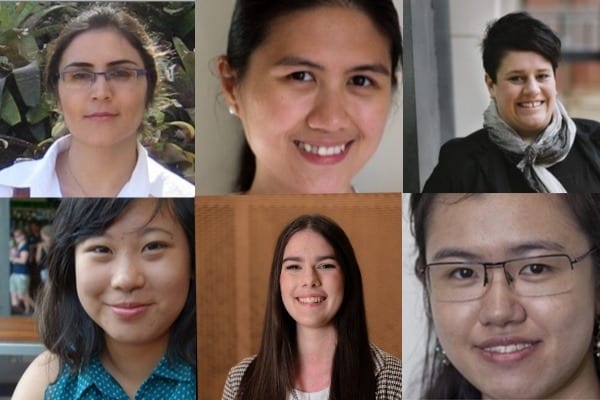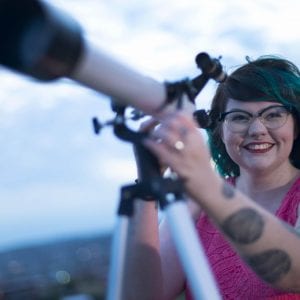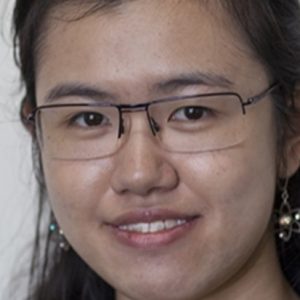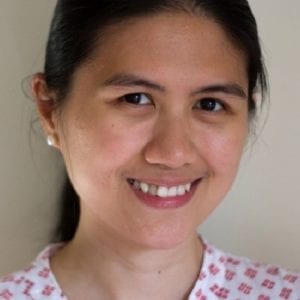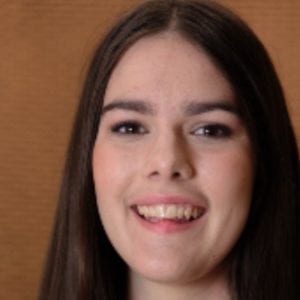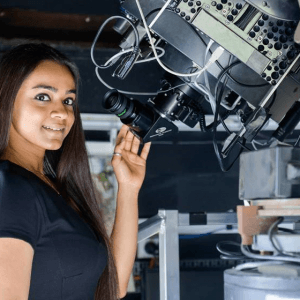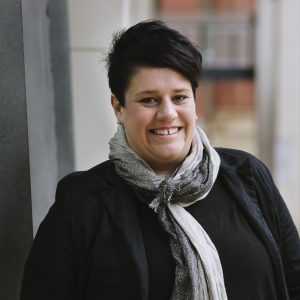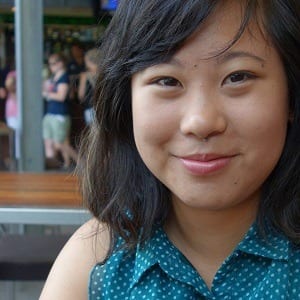But things have been a little slower when it comes to recognising the contribution of women in science.
Just one in every four sources quoted in science stories in Australia are female, and just 18 per cent of biographies on Wikipedia are women.
That’s despite the fact there is absolutely no shortage of talented female scientists available and change is happening when it comes to shifting the number of women going into science and ultimately rising up the leadership ranks.
Below, Jessie Tu shares a list of women to watch in this space. It’s not a definitive list and it’s one that we’re keeping alive to grow further. If you know more women who should be included, please get in contact.
And don’t forget to subscribe to The STEM Wrap, our weekly newsletter for Women in STEM here.
Karlie Noon, astronomer, CSIRO
State: ACT
Field: Astronomy
Alinta Noon is a Kamilaroi woman from the Tamworth region and was nominated for the Young Australian of the Year in her state last year. She completed a double major in pure maths and physics and became the first in her family to attend university at the University of Newcastle. She landed a job with CSIRO’s Indigenous STEM Education Project and is mentoring girls in STEM and advocating for Indigenous astronomy. Jazmeen Payne profiled Alinta Noon earlier this year for Women’s Agenda, as a finalist for the 2019 Women’s Agenda Leadership Awards.
Lindell Bromham, evolutionary biologist, ANU
State: ACT
Field: Biology
Lindell founded the Network for Women in Biology at ANU in Canberra. She’s worked in macroevolution (the study of evolution of groups larger than an individual species) and macroecology (the study of relationships between organisms and their environment) and is creating new ways of using molecular data to uncover new theories of evolution.
Cleo Loi, astrophysicist, University of Cambridge
State: NSW
Field: Astrophysics
At 23, Cleo was a physics student at the University of Sydney when she proved the existence of plasma tubes inside our planet’s magnetosphere. This extraordinarily talented astrophysicist is now completing her PhD at the University of Cambridge, where she is a member of the Department of Applied Mathematics and Theoretical Physics Astrophysical Fluid Dynamics research group.
Madeleine Schultz, lecturer in chemistry, Deakin University
State: VIC
Field: Chemistry
Madeleine is a lecturer in chemistry at Deakin University and has focused her research on how tertiary chemistry teachers can aptly transfer skills and knowledge in their field through the evaluation of current practices. In Australia, male science teachers continue to outnumber female science teachers, but Madeleine’s contributions are changing things for the better.
Marzi Barghamadi, experimental scientist, CSIRO
State: VIC
Field: Energy Technology
After completing her PhD on lithium sulfur batteries at Swinburne University of Technology, Marzi began work at CSIRO developing new energy storage devices. When she’s not in the lab testing out new materials, she supervises postgraduate students studying advanced lithium batteries.
Emma Johnston, marine biologist, UNSW
State: NSW
Field: Marine Biology
Emma is a world-leading marine ecologist and Dean of Science at the University of NSW. She has travelled widely to conduct experiments in diverse environments, combining the disciplines of ecology and biology to determine the impact of marine biological invasions and strategies for improving global estuarine heath.
Debra Bernhardt, biomechanic and professor, University of Queensland
State: QLD
Field: Biomechanics
Debra is a lecturer and professor in biomechanics and nanotechnology at the University of Queensland. She combines computational methods with theory to develop ways of understanding molecular matter and hopes to discover new materials to help our understanding of devices, fluids and materials.
Jacqui Romero, physicist, University of Queensland
State: QLD
Field: Quantum mechanics and quantum information
Jacqui completed a Masters in physics in her home country of the Philippines, and did her PhD at Uni of Glasgow. She works at the Quantum Technology Lab at the University of Queensland, as the associate investigator. She’s an advocate for more diversity in STEM and was interviewed by our journalist Madeline Hislop’s article here for Women’s Agenda.
Krystal De Napoli, astrophysics student, Monash University
State: VIC
Field: Astronomy
Krystal is a Gomeroi woman and astrophysics student at Monash University. As the first in her family to attend university, Krystal combines her cultural and ancestral knowledge of the cosmos with academic studies of astronomy and mathematics. She is majoring in astrophysics and a strong advocate for Indigenous sciences, which she explores through public presentations and research.
Onisha Patel, biologist, Walter and Eliza Hall Institute of Medical Research
State: VIC
Field: Structural Biology
Onisha is a structural biologist at the Walter and Eliza Hall Institute of Medical Research (WEHI) in Parkville, Victoria. Her cancer research has focused on creating new ways to tackle protein, cell growth and protein molecules to enable the design of alternative therapeutics for cancer treatments. She has presented her research to a diverse audience through school visits, art exhibitions, and Open House Melbourne events.
Macinley Butson, inventor
State: NSW
Field: Medical engineer
In 2016, Macinley was the first ever Australian to win 1st place at the INTEL International Science and Engineering Fair in its 68 year history. She was 16 years old. She was also name 2018 NSW Young Australian of the Year and Youth Ambassador at last year’s Sydney Science Festival. Butson has invented many incredible machineries, including a sticker that tests when water is safe to drink, that is capable of potentially saving millions of lives from dangerous biologically contaminated water. She also produced “SMART Armour”, a radiation shield that has the potential to remove up to 80% of unwanted radiation exposure reaching non-treated breast during radiotherapy cancer treatment. Anything this powerhouse of a woman can’t do? Oh, she also won Woman of the Future Award this year and the Stockholm Junior Water Prize in September. We profiled her this year when she was a finalist for our Women’s Agenda Leadership Awards.
Adriana Verges, associate professor and ecologist, UNSW
State: NSW
Field: Marine Ecology
Barcelona-born marine ecologist and storyteller Adriana Verges has focused on projects that highlight the ecological impacts of climate change and the conservation of the world’s algal forests and meadows, which are increasingly under threat. As an associate professor at the UNSW, she is inspiring the next generation of young female scientists to experiment with new ways of communicating science to the wider public.
Devika Kamath, astrophysicist, Macquarie University
State: NSW
Field: Astrophysics
Devika is an Astrophysicist and Lecturer in Astronomy & Astrophysics at Macquarie University. After completing her postdoctoral research fellowship in Belgium, she pioneered a search strategy for rare stellar fossils and dying stars. She was recently awarded the prestigious Australian Research Council DECRA fellowship to further develop her research. She is actively involved in student training and outreach programmes which improve Australia’s STEM community, especially for young girls.
Hannah Brown, epigenetics expert, University of Adelaide
State: SA
Field: Paediatrics and Reproductive Health
Based at the University of Adelaide’s Centre for Nanoscale Biophotonics, Hannah is a former researcher in women’s health and fertility and current Chief Science Storyteller at the South Australian Health and Medical Research Institute. She has travelled to France and the United States for research and her PhD was on Reproductive biology. She is passionate about science communication and engaging new audiences with creative storytelling.
Hilary Goh, geologist, SounDelve
State: WA
Field: Geology
Hilary studied geology at Wollongong before obtaining her Honours in Tasmania. As a geoscientist, she applied robotics hardware to create 3D mapping. As a member of Women in Mining, she recently got together with some friends and founded the Perth Machine Learning Group where they help each other code for machine learning through weekly meetups and discussions.
Sharna Jamadar, biomedical researcher, Monash University
State: VIC
Field: Psychology
Sharna is an expert in neuroimaging and Senior Research Fellow at Monash Biomedical Imaging. She also works at the Monash Institute for Cognitive and Clinical Neurosciences, where her research focuses on understanding various cognitive resilience to combat ageing process. Sharna is a member of the Gender Equity and Diversity Committees of the Australasian Neuroscience Society and co-founder of the Australasian Women in Neuroscience Network.
Anna Dean, veterinary epidemiologist, World Health Organization
State: NSW
Field: Epidemiology
After completing her PhD in epidemiology in Switzerland, Anna conducted further research in Côte d’Ivoire and Togo. She now works for the World Health Organization, developing new strategies for combating drug-resistant tuberculosis and assisting governments with implementing effective treatment for citizens.
Danielle Meyrick, radiochemist and chief scientific officer, Theranostics
State: WA
Field: Oncology
Danielle was one of the first radio-chemists in Australia to produce targeted therapies in treating neuroendocrine tumour treatment and prostate cancer. In addition to her role as resident doctor at Sir Charles Gairdner Hospital in Perth, she was lecturer in analytical and chemical sciences at Murdoch University and Councillor of The Australian Institute of Nuclear Science and Engineering.
Kelly Wong, science educator, The Science Channel
State: SA
Field: Education
After studying biomedical science in Queensland, Kelly completed her PhD, researching human B cell responses to grass pollen allergy. She expanded her skills into media through social media and science communication. She works as the online producer at The Royal Institution of Australia, which includes brands such as Australia’s Science Channel, Cosmos Magazine, SCINEMA International Science Film Festival. She is invested in using social media to engage existing and new audiences with science.
Shyuan Ngo, motor-neuron scientist, University of Queensland
State: QLD
Field: Metabolic diseases
Shyuan’s research attempts to understand the causes and consequences of metabolic dysfunction in motor neuron disease and develop new therapies for people who suffer with MND. Internationally renowned, Shyuan has collaborated with researchers and neurologists across the world and has won numerous fellowships in Australia.
Kate Charlton-Robb, Conservation geneticist and dolphin researcher, Monash University
State: VIC
Field: Conservation
As a zoologist, molecular geneticist, and founding director & principal researcher of the Australian Marine Mammal Conservation Foundation, Kate has found time to write for publications like the Sydney Morning Herald, highlighting the social issues and gender disparities female scientists face in Australia. She is a sought-after commentator and expert on marine issues in the media.
Michelle Lim, clinical psychologist and researcher, Swinburne University
State: VIC
Field: Psychology
Michelle researchers loneliness and its effects on young people. She works with companies to develop apps and videos that combat loneliness and advocate for further scientific research on how our lives are simultaneously compromised and improved by technology. As chairwoman of the Australian Coalition to End Loneliness, she oversees research and advocacy to combine science, government agencies and charities in the search for quality strategies to manage loneliness.
Ayesha Tulloch, conservation biologist, Sydney University
State: QLD
Field: Conservation
Ayesha is passionate about the ecology of birds and mammals, beginning her career as a ranger with the National Parks and Wildlife Service in Royal National Park in NSW. Her PhD focused on strategizing processes to the management of threats against biodiversity in Queensland. She also undertook roles as research fellow across a number of universities. More recently, she travelled to Madagascar to work with the Wildlife Conservative Society to develop human subsistence conservation.
Amanda Lilleyman, ecologist, Charles Darwin University
State: NT
Field: Ornithology
As a lifelong birdwatcher, Amanda’s interest has taken her to the remotest regions of Australia where she is studying the effects of climate change on migratory birds. She is the winner of numerous awards and scholarships for her research and helps increase the exposure and awareness of habitat destruction in her role as Team Leader at Conservation Volunteers Australia.
Misty Jenkins, immunologist, Walter and Eliza Hall Institute of Medical Research
State: VIC
Field: Medical Science
As well as having a background as a medical research scientist, Misty is Laboratory Head at the Walter and Eliza Hall Institute of Medical Research in Victoria , a L’Oréal Women In Science Fellowship recipient and ambassador for Poche Centre for Indigenous Health. In 2016, she was named in the Westpac/Australian Financial Review Top 100 Women of Influence in the field of Innovation.
This list is still open and growing! If you know an extraordinary woman to watch in science, let us know at [email protected]

